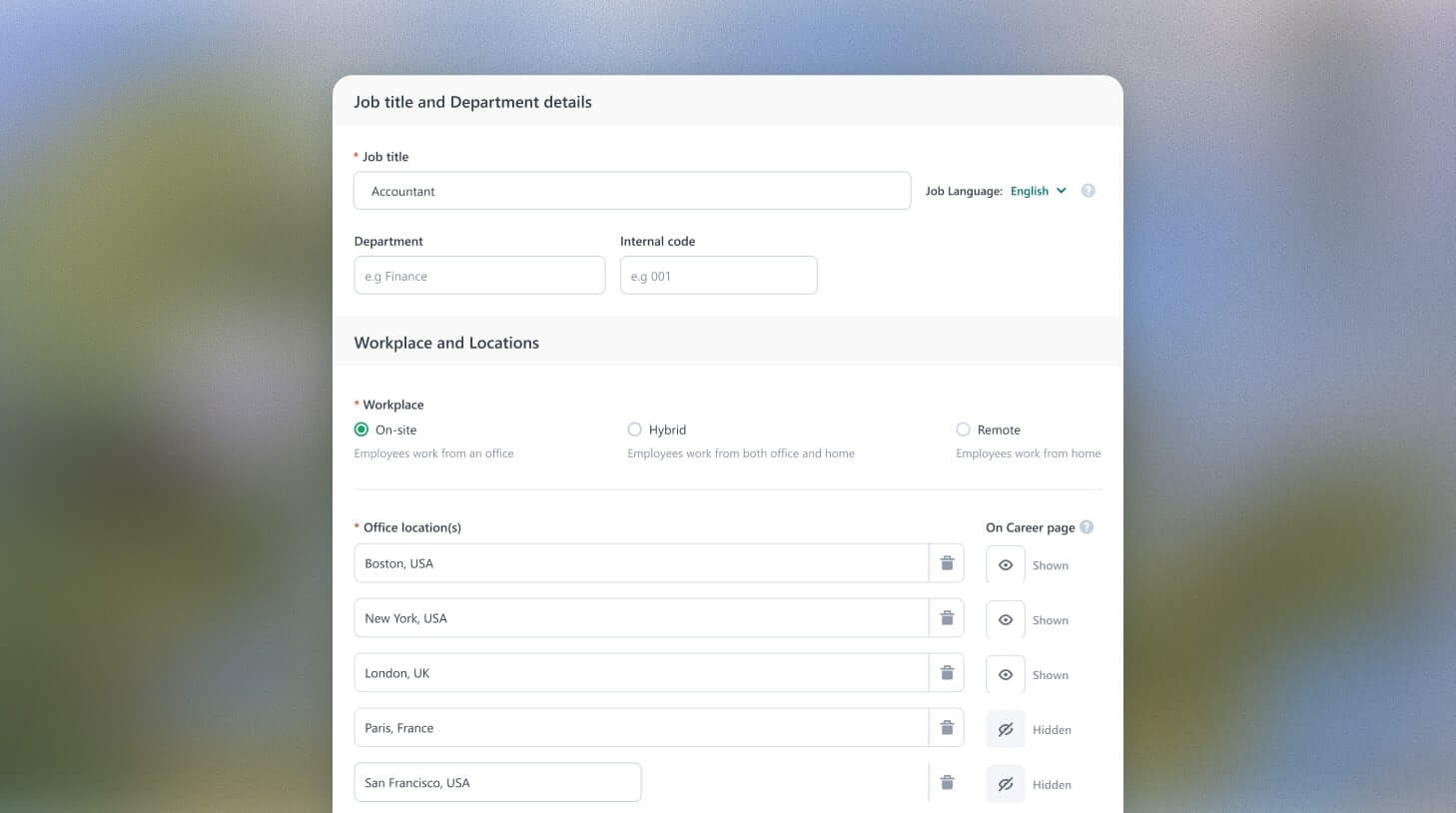6 workplace stories that will give you the pumpkin chills
We are happy to share with you once again some horrible workplace stories from employees. These real-life stories may seem un-BOO-lievably bad at first glance, but they can be very insightful. Let us explain.

Imagine on a spooky Halloween eve at a company close to your office. As dusk falls, the Slack channels suddenly come alive.
Messages from accounts of old colleagues, who left the job under unclear circumstances, start popping up, sharing ghostly gripes about bugs they never managed to fix.
With each eerie emoji and spooky screenshot, a cold breeze of past frustrations sweeps through the sleek office. The ghosts of former coders moan about their never-ending backlog, spooking the current team into a fixing frenzy.
Employees start to panic, but quickly understand that this was just a prank.
Contents
Horrifying workplace stories do exist
I know we set the expectations high but talking about reality things are different.
We don’t have ghosts, but we do have bad employees or employers. We are not afraid of the cold, but we don’t like cold relationships within the company we work for. We don’t have fictional stories, but we have real and even more terrifying experiences from our previous roles.
Related: 15 job interview horror stories that you won’t believe
Every story that you will read below has a difficult situation, a lesson to be learned, and action items (or let’s say treats) to avoid it happening in your company.
Take the steps after each story, and you won’t have to worry about making it to this list in the coming years.
Are you ready for spooky workplace stories and lessons to be learned from each? And please, don’t creep up with our titles because they are all coming from related scary movies or songs.
1. Terrifier
Some colleague gestures can be terrifying. Let’s consider the story above about a hygiene incident that makes people feel uncomfortable.
“In my previous job, the HR manager visited the workplace kitchen to pour herself a cup of coffee. There was already a coworker in the kitchen who was also helping themselves to some coffee.
“At one point, the coworker picked up the teaspoon that was inside the sugar container, ate a teaspoon of sugar, and then put the teaspoon back inside the sugar container. The HR manager was obviously baffled and had to explain basic hygiene to our coworker.“
Lesson to be learned
We avoid sugar as it is unhealthy.
Just kidding.
Maintaining good hygiene at the workplace is paramount for several reasons.
Firstly, it helps in fostering a healthy environment, reducing the transmission of diseases like the common cold, flu, and even more serious illnesses, which in turn decreases absenteeism.
Secondly, a clean and hygienic environment enhances the overall image and perception of the business, showing professionalism and care towards both employees and clients. Thirdly, it promotes a sense of well-being and satisfaction among employees, which can boost morale and productivity.
Furthermore, adhering to hygiene standards is often a legal and regulatory requirement in many industries, particularly in healthcare and food service, where poor hygiene can have dire consequences.
Lastly, good workplace hygiene practices like regular cleaning, waste management, and personal cleanliness contribute to creating a safer workplace by preventing accidents and ensuring the well-being of everyone on the premises.
Action items
To avoid hygiene incidents at work, it’s crucial to establish and communicate clear hygiene policies that align with local health regulations.
Regular training sessions should be organized to educate employees on the importance of hygiene and proper practices. You can use posters on the walls to help your employees understand the process of using common devices or working materials.
Providing adequate hygiene facilities like restrooms and sanitization stations, along with necessary supplies such as soap and hand sanitizers, is fundamental.
Scheduling regular cleaning, maintenance, and hygiene inspections will help in ensuring a clean and compliant environment.
In this case, establishing a reporting mechanism for hygiene concerns and recognizing good hygiene practices among employees could be very helpful.
2. A quiet place
The restroom is always a quiet place, but in this story, it was an actual workplace.
“I worked as an assistant and received a call at 8:00 pm on a Friday while I was out at a bar. My boss had missed their ferry and could not get on another one. My boss said I had to figure it out right then and there, or they would miss a “networking” party that was apparently of utmost importance.
“I called the ferry company from the bathroom of the bar to find out if I could purchase a ticket for the last ferry out. They informed me that it was completely sold out and there was no way to get my boss and their car onto the ferry.
“There was no other option than to be completely honest with the ferry company. ‘I am locked in a bathroom stall at a busy bar, trying to complete this task, and I know that if I fail, I will be in a lot of trouble on Monday’, I said.
“They took pity on me (I mean, who wouldn’t) and the ferry company allowed my boss to get on the ferry even though they were at capacity.
“The whole ordeal took an hour, and not only did my boss JUST make the ferry by 3 minutes, but someone sent the bouncer into the bathroom to check on me because I had been in there for so long.
“To add to it all, I then had to call and RSVP to said party for my boss… the night before the event… and they made sure to ask me if my boss would prefer lobster or steak.”
Lesson to be learned
Steak is always a better option.
Again, kidding.
Achieving a harmonious work-life balance is essential for both personal and professional fulfillment. It entails managing career demands alongside personal responsibilities and leisure activities, ensuring neither sphere is neglected.
A well-rounded work-life balance contributes to improved mental and physical health, reducing stress and the risk of burnout. It fosters enhanced productivity and creativity at work, as individuals are more likely to feel motivated and less fatigued.
Additionally, a satisfactory work-life balance supports better relationships with family and friends as it allows for quality time and engagement outside the professional realm.
Moreover, it cultivates a positive organizational culture, attracting and retaining talent while promoting a holistic approach to employee well-being. The ripple effect of a balanced work-life dynamic extends beyond the individual, benefiting families, communities, and organizations at large.
So, when thinking about the best choice between lobster or steak, just remember that everything in life is the result of our choices. The same applies to jobs as well.
Action items
To foster a better work-life balance, it is critical to respect the working hours and maintain job responsibilities that reflect the actual role.
A toxic boss can cause employees to leave their jobs, regardless of their qualifications, thereby harming your own business. Keep boundaries within reason and don’t confuse your personal life with your professional life.
While it is really difficult to confront a toxic boss, there are steps that HR can take to balance work life with personal life, making employees feel satisfied with their jobs.
As a first step, implementing long-term flex work or remote work options, allowing employees to tailor their schedules to personal needs.
HR should also consider introducing a robust paid time-off policy, encouraging employees to take breaks for rest and personal pursuits.
Your company can also promote a culture that values balance through regular communication and workshops on time management and stress reduction.
Establishing clear boundaries between work and personal time, such as discouraging after-hours emails and meetings, can help in maintaining this balance.
3. Want your bad romance
Workplace affairs may look interesting for a movie, but in real life, things are different. A bad romance could cost you your job, or even worse, harm your own business. And we have a true story about that.
“I once worked in an early-stage start-up where it was clear that my boss was having marital issues. It was a very early-stage company, and only a handful of us were in the regional office, so it was difficult for him to hide his black eye when he came in one day.
“It turned out that he was having an affair with a colleague from an office in a different country. When he confessed to his wife that his next trip away for a week was actually to see his mistress and not work from the other office, his wife punched him in the face and cut up his passport in front of him.
“At the next company retreat, things between them became official, and the founders of the company discovered their secret affair when they started making out in front of everyone after a few drinks at the work party. The worst thing was that it wasn’t the only affair that happened on that company trip.“
Lesson to be learned
You don’t need to be a Don Juan at your work.
Navigating the terrain of workplace relationships can be complex, and often, maintaining a clear boundary between professional and personal interactions is advised.
This distinction is crucial for several reasons.
Firstly, it helps in preserving objectivity and impartiality, ensuring that decisions are made based on merit rather than personal affiliations.
Secondly, it reduces the potential for conflicts of interest or perceived favoritism, which can negatively impact team dynamics and morale.
Thirdly, it minimizes the scope for personal issues to infiltrate the professional environment – like it happened in the above story – thereby maintaining a focused and productive work atmosphere.
Lastly, maintaining a professional demeanor at work contributes to building a respectful and harmonious workplace culture, which is conducive to the overall growth and success of the organization.
Action items
To prevent complications arising from personal relationships at work, HR professionals or company owners should establish clear policies regarding such relationships, especially between supervisors and subordinates, ensuring there’s a process for disclosure and management of conflicts of interest.
Regular training can educate employees on the importance of professional boundaries. Open communication channels should be established for discussing concerns, alongside robust conflict resolution mechanisms.
Transparency and disclosure of personal relationships should be encouraged, with regular monitoring to identify potential issues.
Fostering a professional work environment, creating alternative reporting structures, and establishing feedback loops can further mitigate challenges.
4. It
This boss is the one who floats new jobs over to you – like Pennywise – even after you think you’re done work for the day. And then before you know it, they’re gone.
“I once had a boss who loved to power trip. During a 6:30 PM call, she asked me to create a PowerPoint for her client meeting later that week. I informed her that I would have it finished by the end of the day tomorrow, but I needed to confirm a few things with the product team first.
“She criticized me, saying that I should already know the answers and shouldn’t need input from the product team. She emphasized that it was urgent. Naively, without realizing that I should have stood up for myself, I stayed up late working on the PowerPoint for her.
“I completed it that night and sent it to her for feedback. However, I never received any response from her. Two days later, when I checked on the deck, I discovered that she hadn’t even opened it. It seems that it wasn’t as urgent as she claimed.
Lesson to be learned
Messages are practicing social distancing from eyeballs too.
Maintaining defined working hours – and respecting them – is crucial for several reasons. Firstly, it helps in establishing a clear structure and routine, which is beneficial for both the employer and employees.
This structure aids in managing workloads effectively, ensuring that tasks are completed within set timelines.
Secondly, adhering to specified working hours promotes a healthy work-life balance, as employees can plan their personal activities around their work schedules.
Thirdly, it fosters a sense of fairness and equality within the workplace, as all employees are expected to abide by the same working hours.
Fourthly, it aids in compliance with labor laws and regulations, which often stipulate the maximum working hours and overtime provisions.
Lastly, maintaining consistent working hours helps in building a professional work culture, setting clear expectations regarding availability and commitment, which in turn contributes to better productivity and a harmonious working environment.
Action items
To ensure adherence to defined working hours, it’s important to set clear working hours policies outlining the standard time of work, overtime, and procedures for requesting changes in work schedules.
Communicating these policies effectively to all employees is crucial. Implementing time-tracking tools can provide a transparent way to monitor attendance and working hours.
Training managers on the importance of respecting working hours and how to manage their teams within these constraints is also essential.
Encouraging employees to voice any concerns regarding working hours and being open to providing flexible working arrangements where possible can also promote adherence.
5. The haunting
Haunting or hunting, this story has many definitions. From the haunted truck that doesn’t move to the hopeless hunt for better working conditions, this story will remind you of the first jobs you had to do in your early years to earn your first money.
“When I was about 19 and willing to take on (almost) any job, I took on a role as a mobile ice cream vendor with an ice cream cart – basically, an ice box on bicycle wheels with pedals so you could ride it to any location and sell ice cream bars to anyone who wanted it.
“It was a commission-paid position so we only got to make decent money if we could sell enough ice cream bars throughout the day. Us new hires were assured that we’d make pretty great money doing this.
“My very first day was perfect for ice cream – a hot summer day. A truck filled with ice cream carts came around and picked up all of us and dropped us off at strategic locations throughout the city with the promise that they’d come back to get us at a specific time later that evening.
“When they dropped me off, they gave me a broken ice cream cart with no pedals on it, meaning I was not mobile at all. They also told me not to go anywhere near the beach because that was forbidden by city bylaws, and not to go anywhere near the street because of another reason I can’t recall.
“Basically, I had to stay put in an awkward location next to a large parking lot with no ability to go anywhere, even for a quick lunch break.
“And then they were two hours late coming back to pick me up and by that time I was hungry and tired (and not a little bit grumpy!).
“But at least I’d get my commission, right? Well… turned out the commission was so low that when averaged out over the day, I actually made far less than the legal minimum hourly wage. When I protested, they basically said too bad for me and that I should have sold more ice cream bars.
“The next day, I waited 2-3 hours before the truck came around to pick us up – basically, 2-3 hours where I wasn’t getting paid. By the time the truck finally showed up, it was too late – I had already quit and walked home and started looking for another job.”
Lesson to be learned
You will never have an ice cream after reading this.
OK, in all seriousness: respecting employees and providing them with the necessary resources to excel in their roles is fundamental to a thriving organizational culture.
When employees are treated with respect and are well-equipped, they feel valued and empowered, which in turn boosts their morale, job satisfaction, and loyalty to the organization.
This positive environment fosters a collaborative spirit and enhances productivity as employees are motivated to contribute their best.
Providing the necessary tools, training, and a conducive work environment also manifests in the quality of work output, as well-equipped employees can perform their tasks efficiently and effectively.
Action items
To foster a culture of respect and ensure employees have what they need to excel, organizations should engage in regular dialogue to understand employees’ needs and concerns.
It’s crucial to provide the necessary tools, technology, and training that empower employees to perform their tasks efficiently.
Establishing clear communication channels for employees to express their needs, and providing timely responses to such requests, demonstrates respect and consideration.
Promoting a culture of recognition, where employees’ contributions are acknowledged and rewarded, can also reinforce a sense of respect and appreciation.
6. The invisible man
It takes great talent to be an invisible man. This movie title describes both the manager and the candidate. The manager knew how to disappear after making the offer, and the candidate began to question whether all of this was really happening or if it was just in their imagination.
“A few months ago, I had to book flights and travel to another city for an interview. It was a role that I really wanted because it was closer to my ambitions and studies. Fortunately, they liked me and told me that I was going to be hired. I can’t describe how happy I was.
“Before giving my final answer, I asked for two days because it was a big decision for me. I had to give a notice to my other job and to begin the procedures of relocating to a different city. I called the manager who offered me the job, but he didn’t answer. Okay, he must have been busy, I thought.
“So, I sent him an email accepting his verbal job offer. I waited for days to receive a sign of life from him confirming everything we said that day.
“After this short conversation HR finally called me and said, ‘Welcome to our family.’ ‘Okay, great, but when am I supposed to start?’ They told me, ‘I don’t know. Relocate to the city from your hometown, and we will let you know.’ ‘Yes, but I need proof. Can I have an official job offer?’ They replied, ‘Yes, of course.’ They cc’d the manager, and I never heard anything from them.”
Lesson to be learned
There is a skill that makes you invisible.
Experiencing a situation where a hiring manager extends a verbal job offer and then disappears can be disheartening and unprofessional.
This scenario reflects a lack of communication and possibly a lack of respect or consideration for the candidate’s time and expectations.
From a recruitment perspective, this behavior might indicate a lack of transparency, organization, or commitment to following through with the hiring process.
Recruiters and hiring managers should exhibit a high degree of professionalism and clear communication throughout the recruitment cycle to maintain trust and uphold the organization’s reputation.
This situation may also indicate a lack of proper processes or guidelines within the organization for extending job offers and managing communication with candidates.
Action items
To prevent situations like a disappearing hiring manager post verbal job offer, organizations should establish clear recruitment and communication protocols.
Firstly, a structured and documented process for extending job offers, both verbal and written, should be in place, ensuring consistency and professionalism.
Secondly, training hiring managers and recruiters on the importance of clear communication and follow-through with candidates is crucial.
Thirdly, implementing a centralized applicant tracking system for all communications and job offers can provide transparency and accountability.
Fourthly, designating a point of contact within the HR department for candidates to reach out to for updates or clarifications can mitigate communication breakdowns.
Lastly, fostering a culture of respect and empathy towards candidates, and understanding the impact of the hiring process on the organization’s reputation, will help inculcate a more responsible approach towards recruitment communications.
We are sure that now you believe that the most terrifying stories do not come from movies or Halloween, but from real life.
The good news is that we can make an impact and reverse these situations to achieve a positive outcome.
Let’s give a happy ending to all these stories by being more transparent, communicative, and professional with our employees.
Want to read more real-life horror stories from the workplace? Check out Workplace horror stories we wish were not real.
And want to share your own story? Send it to us at [email protected] with “Workplace horror” in the subject heading!




